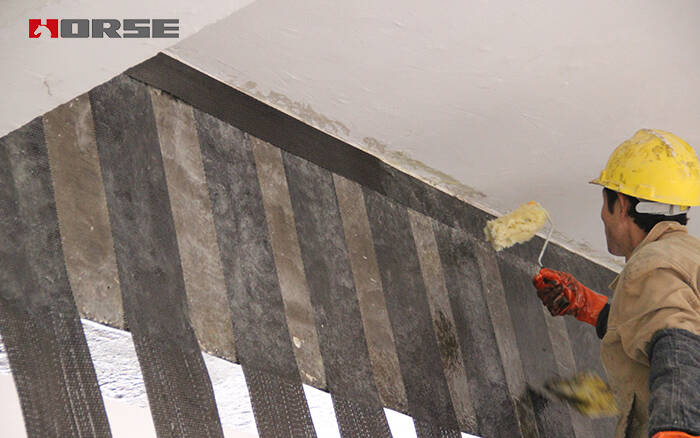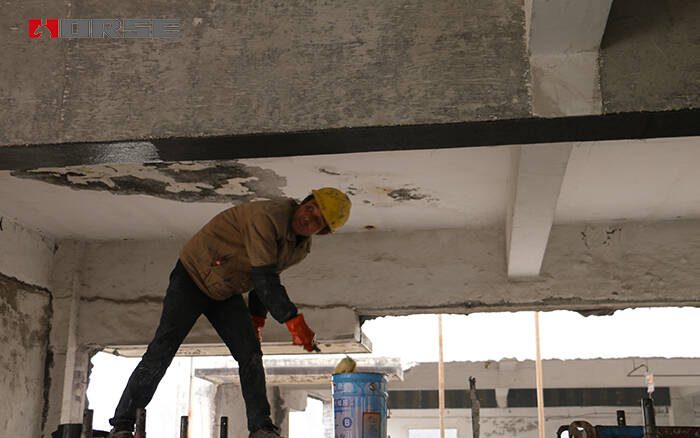Old Building Repair and Maintenance
Old building repair and maintenance - HORSE carbon fiber fabric
As a new advanced structural reinforcement technology, the unidirectional carbon fiber fabric has been widely used in the structural reinforcement of old buildings. Key feature of unidirectional carbon fiber fabric: the labor cost is lower, the construction period is shorter and more economical, the reinforcement effect is very good

Project cases
The original purpose of a certain building structure was an industrial building. It is now planned to carry out structural reinforcement and transformation, so that it can meet the carrying capacity of a cold storage with a capacity of about 1000t. The structure of the building is a cast-in-place concrete frame structure system. The floor slab of each floor is made of concrete structure floor slab with a thickness of 10cm, a concrete strength of C25, and a steel bar strength of HRB335. Precast concrete pipe piles are driven. The building area is about 3600m, with 5 floors above ground and 1 floor underground. The size of the concrete beam of the structure is within the force range, and the size of the column and the concrete strength can meet the force requirement.
Structural test of old building bearing capacity
Before formulating the reinforcement design plan of the old building, the current structure and performance of the building should be tested and inspected. Taking into account the basic technical requirements of the structure, the economic and time indicators of the inspection, three indicators for inspecting the concrete structure of the house are determined. That is, the inspection of concrete strength in concrete structures, including reinforced concrete columns, reinforced concrete beams and reinforced concrete slabs. Inspection of the carbonization depth of reinforced concrete in the structure, including reinforced concrete columns, reinforced concrete beams and reinforced concrete slabs. And to inspect the corrosion degree of steel bars in concrete structures, including reinforced concrete columns, reinforced concrete beams and reinforced concrete slabs. When testing, the surface of the concrete component should be smoothed first to remove dust, debris and other objects that may affect the conclusion of the structural strength. Then the rebound tester is used to divide the measurement area. For different components, separate inspection lots should be divided for springback testing, and when necessary, core-drilling testing should be performed in the testing area. The strength of the drill core is used to correct the rebound strength of the concrete to obtain the most consistent result. In addition, the carbonation depth should be detected for different concrete measurement areas, because different carbonation depths have a certain impact on the detected detection value and will reduce the rebound value, so accurate detection must be performed.
Test results of old building structure
1) Inspect the structural concrete strength of the old building. The test results show that the compressive strength of the building structure concrete can meet the C30 requirement in the original design. As long as there is a slight deviation in the data of a collection point on a floor, the original structural design strength cannot be met. Therefore, in the calculation and reinforcement design of the structure, the strength of the concrete should be carried out using the original design strength. The strength of the column is C25, and the same is true for beams and plates. Because the rebound value meets the requirements of the original design, there is no need to reduce the strength.
2) The results of testing the carbonation depth of the structural concrete show that the carbonation depth of the concrete structure has been relatively deep, and the development is relatively rapid. Due to the deepening of the concrete carbonization, the concrete will lose its alkalinity, which is very unfavorable for the protection of steel bars and will also affect the durability of the structure. Therefore, according to the test results of this test item, the overall reinforcement of the building requires a certain degree of technical treatment. Protect the structure from being corroded, and ensure that the carbonization of the structure can be reasonably developed in the future use of the structure.
3) The report of testing the corrosion degree of the reinforcement of the concrete structure shows that the corrosion of the reinforcement of the reinforced concrete of the building structure has developed to a certain extent, but the corrosion situation is not very serious. The depth and area of the erosion did not reach 1/10 of the original diameter of the steel bar, so the mechanical performance still meets the requirements. This is also mutually confirmed with the carbonization report of reinforced concrete, which serves as the basis for each other's processing. Therefore, how to prevent and delay the corrosion development of steel bars in concrete should be considered in the design plan of the transformation.

Selection of reinforcement plan and scope of reinforcement treatment
1) The protective layer on the surface of the component should be repaired with cement mortar, and the technology with automatic pressure grouting should be used to repair the cracked concrete structural component. Because if the concrete members have cracks, it is not enough to repair them with concrete materials of the same strength. Although strength can be formed temporarily, if there is no glue, the adhesion between the poured concrete is insufficient. Once the strength is formed, it will fall by itself, which will affect the effect of the repair.
2) For the concrete structure cracks found at the bottom of the beam and the bottom of the slab, the method of sticking unidirectional carbon fiber fabric is used to strengthen and treat the components. For the vertical or inclined cracks that occur in the upper part of the beam and the plate, and the cracks that have a certain impact on the bending and shear resistance of the components, unidirectional carbon fiber fabric is also used for reinforcement and treatment of the components. Before carbon fiber reinforcement, the strength of the carbon fiber should be calculated, and the size and quantity of the carbon fiber fabric should be designed to ensure that the force performance after reinforcement can meet the requirements in use later.
3) For the oblique shear cracks generated on the original beams, unidirectional carbon fiber fabric and U-shaped cards are also used for reinforcement, and the primary and secondary beam nodes that have cracks are also reinforced by unidirectional carbon fiber fabric and U-shaped cards. Because the U-shaped card can bear the shear force transferred in the structural system, it is equivalent to adding a part of the stirrup inside the beam body to play a role in shear resistance. Therefore, increasing the U-shaped clamp is of great significance for increasing the strength of concrete, and it is also an indispensable part of reinforcement.
Materials used for reinforcement
1) The standard value of the tensile strength of the materials that should be used in the structural reinforcement plan should not be less than 3000 MPa, the thickness should reach 0.11 mm, the elongation rate should be no less than 1.6%, and other material indicators should also comply with the "Carbon Fiber The relevant requirements of section 3.2 in the Technical Specification for Sheet-Reinforced Concrete Structures. Before entering the site, the construction unit shall check the qualification certificates of the entering materials and the inspection report, and the quality must meet the relevant requirements before entering the site. In addition, sampling re-inspection should be conducted to resolutely exclude unqualified materials from the construction site.
2) For the matching resin-bonded materials, a polypropylene material with a small tow carbon fiber sheet with a tensile strength of not less than 12 should be used for processing. Such materials have the characteristics of strong tensile properties, and can greatly increase the strength of the structure when used in reinforcement. Under the action of this material, components that produce cracks or insufficient strength can meet the specific requirements of tensile strength, which greatly increases the durability of the building structure.
3) The structural materials used, reinforced concrete, etc. should meet the requirements of the current national regulations, the strength of steel bars should not be less than HRB335, the strength of concrete should not be less than C30, and the strength of cement mortar should not be less than M7.5. This kind of strength has been verified by a lot of tests. The underground part uses M10 cement mortar as moisture proof. If the strength is insufficient, the bearing capacity of the bearing wall should be tested and calculated until the bearing capacity and shear capacity can meet the relevant requirements.
Specific requirements for reinforcement with unidirectional carbon fiber fabric
Before reinforcement, the surface of the concrete component should be treated first, and the decorative layer on the surface of the concrete component should be cleaned to expose the structural layer so that the surface of the component can be used for the next step. After cleaning up, the surface of the concrete should be calendered, so that the mortar layer can be easily applied. After leveling, the structural layer is exposed because the decoration layer must be attached to the structural layer to meet the force requirements, so the surface must be treated. After the reinforcement is completed, the relevant acceptance and inspection shall be carried out in accordance with the "Technical Specification for Carbon Fiber Sheet Reinforced Concrete Structures". In the reinforcement process of the carbon fiber fabric, because the carbon fiber is conductive, it should be kept away from the electrical equipment during the construction process to prevent personal injury or death due to the conductivity of the carbon fiber fabric during the installation process. During construction, each layer of concealed works should be checked and accepted, and only when the previous process can meet the construction requirements can it be transferred to the next process. If the previous process does not meet the construction requirements, it should be rectified immediately, and the next process can be entered until it is qualified, otherwise acceptance is strictly prohibited.
Conclusion
As a new reinforcement technology, the reinforcement technology of unidirectional carbon fiber fabric has been widely used in the structural reinforcement of old buildings. The action mechanism of carbon fiber fabric is mainly to share the force of steel bars and improve the bending and shear resistance of concrete members. The advantages of carbon fiber fabric are that the construction is relatively simple, the labor cost is lower, the construction period is shorter and more economical, the reinforcement effect is very good, and it has very good corrosion resistance, and no additional maintenance is required. Therefore, due to this performance, the use of carbon fiber has become more and more widespread. This article briefly introduces the application of carbon fiber reinforcement technology in the renovation of old buildings through the application of carbon fiber fabric reinforcement in a project, hoping to give some guidance to the general colleagues.